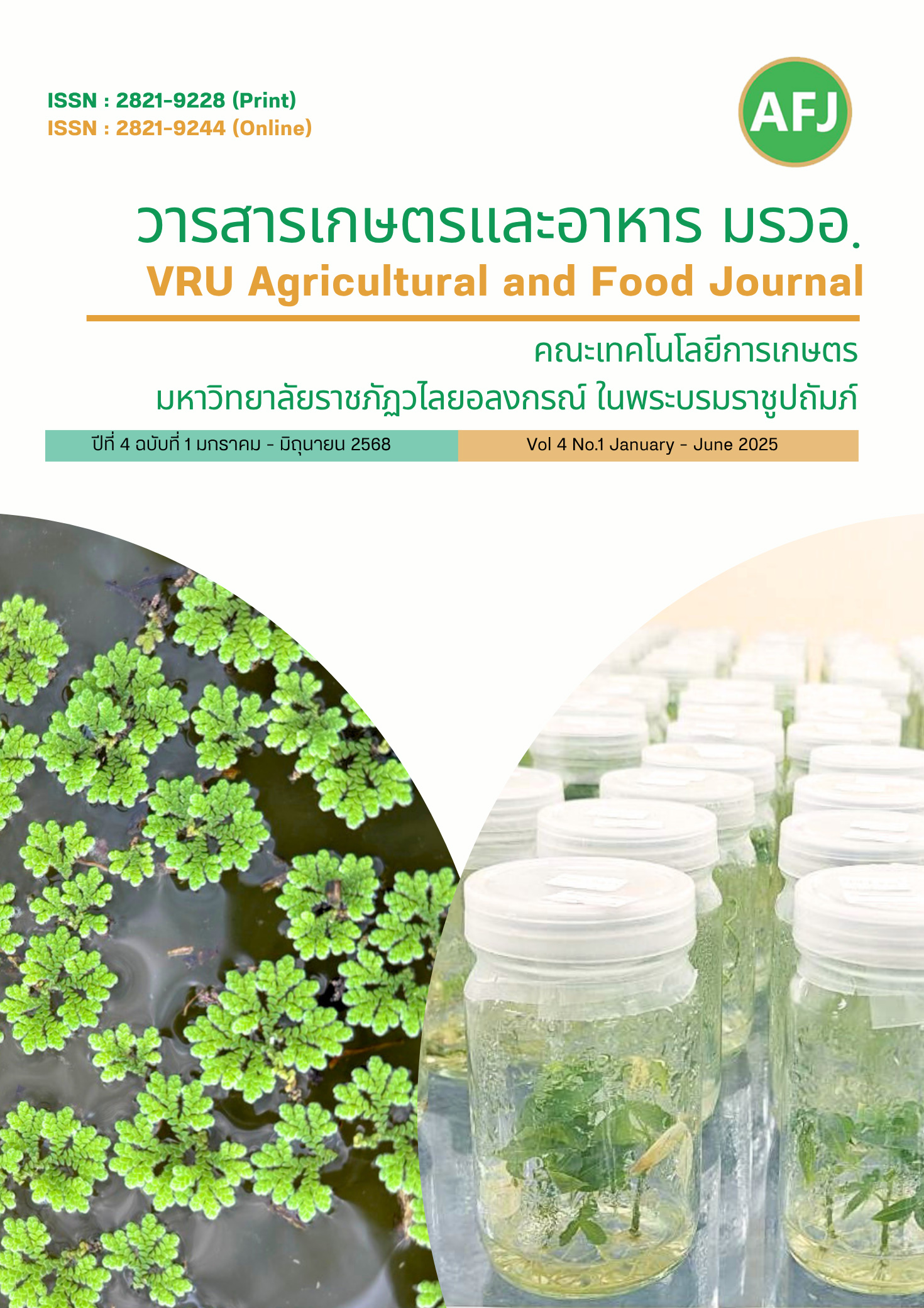ผลของการหมักตอซังในสภาพแปลงนาต่อการเปลี่ยนแปลง คุณภาพน้ำและผลผลิตแหนแดง
Main Article Content
บทคัดย่อ
การวิจัยนี้มีวัตถุประสงค์เพื่อศึกษาวิธีการเพาะแหนแดงที่เหมาะสมในสภาพแปลงนาโดยวางแผนการทดลองแบบสุ่มสมบูรณ์ (CRD) ทำการทดลองเลี้ยงแหนแดง จำนวน 18 บ่อ โดยแบ่งการทดลองเป็น 6 กรรมวิธี ๆ ละ 3 บ่อ ทำการเลี้ยงแหนแดงจำนวน 3 รอบ ๆ ละ 10 วัน แต่ละกรรมวิธี ได้แก่ กรรมวิธีที่ 1 น้ำสะอาดไม่เติมธาตุอาหาร (ควบคุม) กรรมวิธีที่ 2 ปุ๋ยเคมี 46-0-0 กรรมวิธีที่ 3 ดินนา กรรมวิธีที่ 4 ตอซังข้าวหมัก กรรมวิธีที่ 5 ดินนาเติมปุ๋ย 46-0-0 และกรรมวิธีที่ 6 ดินนาผสมตอซังข้าวหมัก ศึกษาคุณภาพน้ำก่อนและหลังการเพาะแหนแดง ได้แก่ อุณหภูมิน้ำ pH ปริมาณออกซิเจนละลายน้ำ ค่าการนำไฟฟ้าของน้ำ ไนโตรเจนรวม และจุลินทรีย์ของน้ำ ศึกษาประมาณผลผลิตแหนแดง ได้แก่ น้ำหนักสดและน้ำหนังแห้ง ผลการศึกษาคุณภาพน้ำก่อนการเพาะแหนแดง พบว่า ทุกกรรมวิธีอุณหภูมิน้ำไม่แตกต่างกัน (p>0.05) กรรมวิธีที่ 6 ค่า pH ต่ำที่สุด (p<0.05) กรรมวิธีที่ 5 การนำไฟฟ้าสูงที่สุด รองลงมาคือกรรมวิธีที่ 6 (p<0.01) ปริมาณออกซิเจนละลายน้ำ กรรมวิธีที่ 1 และกรรมวิธีที่ 2 มากที่สุด (p<0.05) กรรมวิธีที่ 5 ไนโตรเจนรวมสูงที่สุด รองลงมาคือกรรมวิธีที่ 2 (p<0.01) และกรรมวิธีที่ 6 จุลินทรีย์รวมมากที่สุด รองลงมาคือกรรมวิธีที่ 3 (p<0.01) คุณภาพน้ำหลังการเพาะแหนแดง พบว่า ทุกกรรมวิธีอุณหภูมิน้ำไม่แตกต่างกัน (p>0.05) กรรมวิธีที่ 6 ค่า pH ต่ำที่สุด (p<0.05) กรรมวิธีที่ 6 การนำไฟฟ้าสูงที่สุด รองลงมาคือกรรมวิธีที่ 5 (p<0.01) ปริมาณออกซิเจนละลายน้ำ กรรมวิธีที่ 1 และกรรมวิธีที่ 2 มากที่สุด (p<0.05) กรรมวิธีที่ 5 ไนโตรเจนรวมสูงที่สุด รองลงมาคือกรรมวิธีที่ 6 (p<0.01) และกรรมวิธีที่ 6 จุลินทรีย์มากที่สุด รองลงมาคือกรรมวิธีที่ 4 (p<0.01) และปริมาณผลผลิตแหนแดง พบว่า กรรมวิธีที่ 5 น้ำหนักสดมากที่สุด รองลงมาคือกรรมวิธีที่ 6 (p<0.01) และน้ำหนังแห้ง กรรมวิธีที่ 5 และกรรมวิธีที่ 6 น้ำหนักมากที่สุด (p<0.01) เมื่อหาความสัมพันธ์ระหว่างคุณภาพน้ำกับผลผลิตสดของแหนแดง พบว่า อุณหภูมิน้ำ ไนโตรเจนรวม การนำไฟฟ้า และจุลินทรีย์รวม ช่วยส่งเสริมทำให้ผลผลิตของแหนแดงเพิ่มขึ้น การวิจัยนี้สรุปได้ว่า กรรมวิธีที่ 5 ที่หมักดินนาและเติมปุ๋ย 46-0-0 ก่อนเพาะแหนแดง ส่งผลให้ผลผลิตน้ำหนักสดของแหนแดงมากที่สุด และกรรมวิธีที่ 6 หมักดินนาผสมตอซังข้าว ส่งผลให้ผลผลิตน้ำหนักสดของแหนแดงมากรองลงมา แต่ทั้งกรรมวิธีที่ 5 และ กรรมวิธีที่ 6 น้ำหนักแห้งไม่แตกต่างกัน หากต้องการนำแหนแดงเพาะในแปลงนาปลูกข้าวหรือทำกิจกรรมอื่นทางการเกษตรแบบไม่เผาฟางและตอซังข้าว กรรมวิธีที่ 6 ก็มีความเหมาะสมมากเช่นกัน ทั้งนี้ขึ้นอยู่กับการนำไปปรับใช้ในการเพาะแหนแดงของผู้ที่สนใจ
Article Details

อนุญาตภายใต้เงื่อนไข Creative Commons Attribution-NonCommercial-NoDerivatives 4.0 International License.
บทความนี้ได้รับการเผยแพร่ภายใต้สัญญาอนุญาต Creative Commons Attribution-NonCommercial-NoDerivatives 4.0 International (CC BY-NC-ND 4.0) ซึ่งอนุญาตให้ผู้อื่นสามารถแชร์บทความได้โดยให้เครดิตผู้เขียนและห้ามนำไปใช้เพื่อการค้าหรือดัดแปลง หากต้องการใช้งานซ้ำในลักษณะอื่น ๆ หรือการเผยแพร่ซ้ำ จำเป็นต้องได้รับอนุญาตจากวารสารเอกสารอ้างอิง
Ahmad, N. and N. Tariq. 2021. Azolla as Waste Decomposer and Bio-fertilizer: A Review. J. Appl. Plant. Sci. 2(1): 108-116.
Angsuchoti, S. n.d. Techniques for Analysis of Correlation between Variables. Available Source:https://www.stou.ac.th/offices/ore/info/cae/uploads/pdf/636366560441132172.pdf, March 4, 2023. (in Thai)
Bacon, P. and J. Cooper. 1985. Effect of rice stubble and nitrogen fertilizer management techniques on yield of wheat sown after rice. Field Crops Res. 10: 241-250.
Carlile, W.R. 2008. The use of composted materials in growing media. Acta Hortic. 779: 321-328
Chartchumni, B., S. Kumla, S. Somsak and J. Wongjunda. 2022. Climbing perch culture wastewater treatment with Azolla microphylla. Khon Kaen Agric. J. 50(6): 1567–1579. (in Thai)
Chumthong, A. and P. Pakdeechanuan. 2019. Effects of Bioextract on Decomposition of Rice Straw and Growth of Local Rice Variety Ruang Ree. Songklanakarin J. Plant Sci. 6(1): 82-90. (in Thai)
Devi, M.K., W.N. Singh, W.R.C. Singh, H.B. Singh and N.M. Singh. 2014. Determination of the ability of Azolla as an agent of bioremediation. Eur. J. Exp. Biol. 4(4): 52-56.
Lamont, J.R., O. Wilkins, M. Bywater-Ekegärd and D.L. Smith. 2017. From yogurt to yield: Potential applications of lactic acid bacteria in plant production. Soil. Biol. Biochem. 111: 1-9.
Mohsen, A-T. 2006. Effect of Free-Floating Macrophyte, Azolla pinnataon Water Physico-Chemistry, Primary Productivity, and the Production of Nile Tilapia, Oreochromis niloticus (L.), and Common Carp, Cyprinus carpio L., in Fertilized Earthen Ponds. J. Appl. Aquaculture. 18(1): 21-24.
Wimoonchart, P., P. Chutimanukul and O. Thepsilvisut. 2021. Effect of Cow and Pig Manure on Growth and Yield of Azolla microphylla. Khon Kaen Agric. J. 49(6): 1364–1374. (in Thai)
Yamdeeka, C., P. Nakayan, S. Konsaen, P. Areesrisom and W. Nilawonk. 2023. Influence of Bio-extracts on Plant Nutrient Release from Rice Straw. Maejo J. Agric. Prod. 5(2): 67–78. (in Thai)
Zakarya, I. A., N.A. Nasir, N. Razali, M.H. Ibrahim and M. Baboc. 2023. Assessment of Water Quality and Nutrient Uptake of Azolla in Different Fertilizers. IOP Conf. Ser.L Earth Environ. Sci. 1216(1): 012039.

